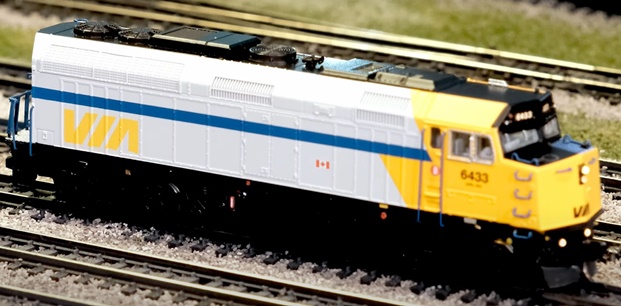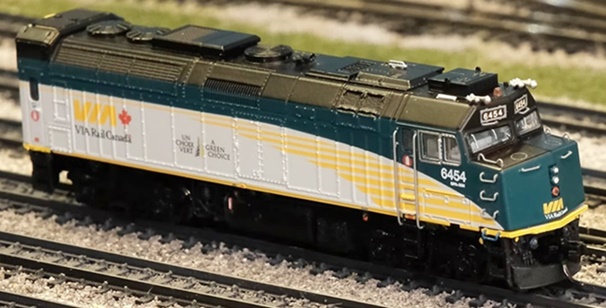



Introduced: 2022
These finely detailed and smooth running models are available either DCC-Ready or with factory-installed ESU LokSound decoders. As pictured above, they are available in either "as delivered" or "rebuilt" detailing packages. And believe it or not, this is actually the second version of this model (the original release having been a complete disaster that had to be returned to China and completely rebuilt before any were ever actually sold to the public).
The main chassis consists of a hunk of mostly black metal. A plastic undercarriage piece clips to the sides of the main chassis. An extra metal "lid" is screwed to the top of the main chassis over the rear truck. The motor (a round "can-style" jobber, and presumably five-pole / skew-wound) lives in the center of the chassis. A large flywheel is attached to each motorshaft. Dogbone w/ notched-cup U-joints connect the flywheels to the wormshafts. Two screws hold the main PC board to the rear of the chassis. These same screws also serve to hold the speaker to the PCB. A box with the light-conducting plastic for the numberboards screws to the front of the main PC board. A plastic "cab detail" piece sits over the forward truck (plugged into holes in the chassis). The decoder attaches to the main PC board via a Next18 DCC interface.
The worms seat inside of the swiveling truck towers. The trucks are loosely held inside the chassis by plastic arms clipped to the tops of the trucks. There are no traction tires, so all eight wheels provide pickup (a spare TT-equipped wheelset is included in the parts bag should you want to go that route). Axle-wipers collect current from metal collars on the wheels and transfer it to contact strips inside the chassis via sticky-uppy contacts on the wipers. Sprung contacts running through holes in the chassis transfer current from the contact strips to the PC board. The spare parts bag for the "as built" version includes extra traction tires and various bits of "do it yourself" detailing (sunshades, sinclair antenna, bug shields, A/C). The same may be included with the "rebuilt" version, I'm not sure.
These models come equipped with a rather astounding array of lighting features - Headlight (F0), Ditch Lights (F6), Numberboard Lights (F14), Headlight Dimmer (F7), Rear Backup Light (F12).
All four axles are geared and all of the gearing (apart from the worms) is black plastic. The couplers are chassis-mounted MTL's (or if they're not MTL's, they're very close MTL clones). The wheels are low-profile, so no problems on Atlas C55 rails.
The plastic shell is a one-piece casting with numerous press-fit details.
Out of the box, my sample was completely DOA. Fortunately, that problem was easily solved by removing the shell and pushing down on the decoder (which evidently wasn't seated quite properly). Then came the traditional gauge adjustments and wheel cleaning (mine needed a lot of the latter). Once all that was taken care of, performance turned out to be quite outstanding - silky smooth, whisper quiet, realistic top-end speed, one-tie-at-a-time slow speed crawl, no problems on sharp curves, decent sound, etc. On the downside, pulling power is not particularly impressive as mine can only handle about ten passenger cars on level track (any more than that and the wheels are slipping in curves). And I don't know that traction tires are a particularly viable solution (given the finicky nature of DCC-Sound pickup and the fact that the engine only has eight current-conducting wheels to begin with). On the nitpick front, the rear handrail assembly is easily dislodged and annoyingly fragile. And beyond all that, I'm just not really sold on the overall design of the mechanism (at least as far as maintenance goes). Cleaning the contact strips inside the chassis would seem to be a virtual inevitability, but removing the trucks in order to do so looks to be an exceedingly painful procedure. So, a decent model in most respects, but no "A" rating here.
Prototype -
VIA's F40PH-2D has been the face of passenger train travel in Canada since the 1980s. They were built in London, Ontario between 1986 and 1989. They feature a desktop control stand (hence the "D" in the designation); a unique fuel tank and underframe arrangement; a unique carbody design with custom panel and door locations; and numerous other Canadian-only details.
Model Features -
- Scaled from original blueprints and field measurements
- Unique Canadian F40PH-2D body and details
- Working headlights, ditch lights, number boards
- Separate grab irons and handrails installed at the factory
- Incredible underbody detail including separate piping
- Different rooftop details for different paint schemes
- Accurate F40PH-2D sounds on sound-equipped models
- Available in original scheme (1986-1998) and Canada scheme (1998-2014)
Shell Removal -
The shell is held to the chassis by way of four plastic claws molded into the insides of the shell. Insert some toothpicks (or whatever) between the shell and the chassis to free up said claws and the shell should readily slide up and off. Don't forget to free the rear handrails from the steps before doing so. And do be very careful with the handrails on the rear porch of the "as delivered" units. They are easily dislodged and not particularly easy to put back.
Grade: B